Key takeaways
- Self-assessment is vital for musicians to identify strengths and areas for growth, enhancing both skills and audience connection.
- Engaging with recorded performances and audience feedback provides valuable insights into technical execution and emotional delivery.
- Implementing targeted improvements based on critique helps refine performances, turning feedback into actionable steps for future gigs.
- Maintaining audience engagement, even during quieter moments, is crucial for fostering a stronger connection with the crowd.
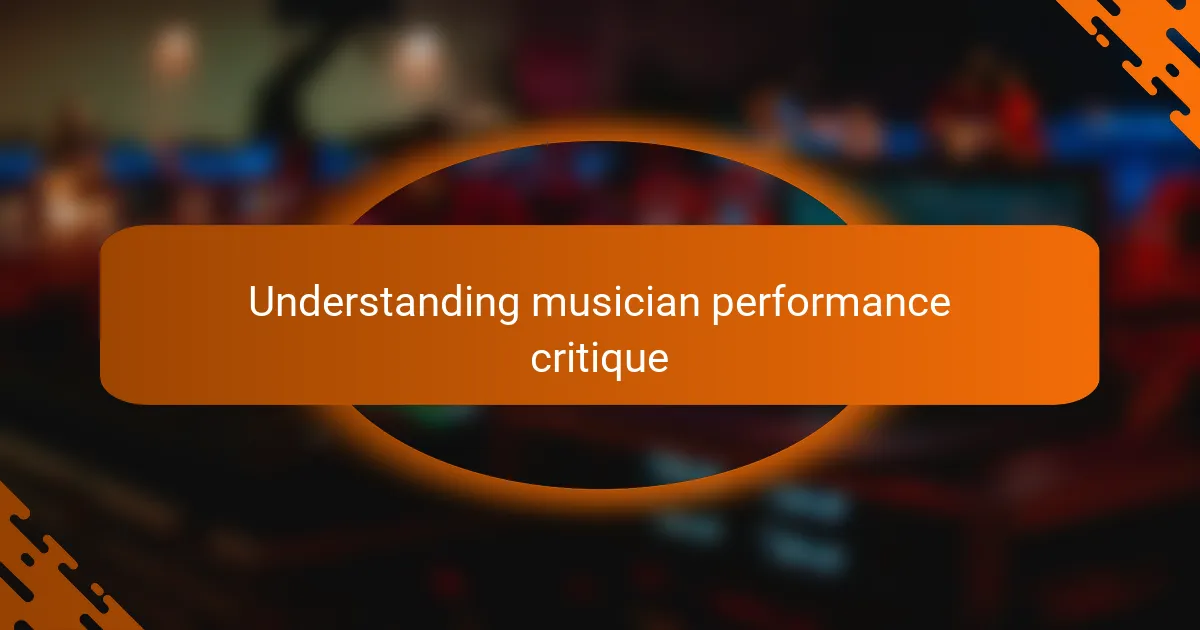
Understanding musician performance critique
Understanding musician performance critique involves a deep and honest evaluation of every aspect of a live show. After one of my most memorable gigs, filled with excitement and nerves, I spent time reflecting on my performance. I realized that my connection with the audience really made a difference; their energy impacted my delivery, but I also noticed areas where I could have engaged more effectively.
When critiquing your performance, consider the following aspects:
- Setlist Choices: Did the selected songs maintain audience interest?
- Stage Presence: How did you interact with the crowd?
- Technical Execution: Were there any moments of hesitation or mistakes?
- Emotional Delivery: Did your performance convey the right emotions?
- Audience Response: How did the audience react during and after the show?
Engaging in this evaluation can be a humbling yet enlightening experience. When I faced what I perceived as my biggest mistakes, I learned that these moments often hold the key to genuine growth.
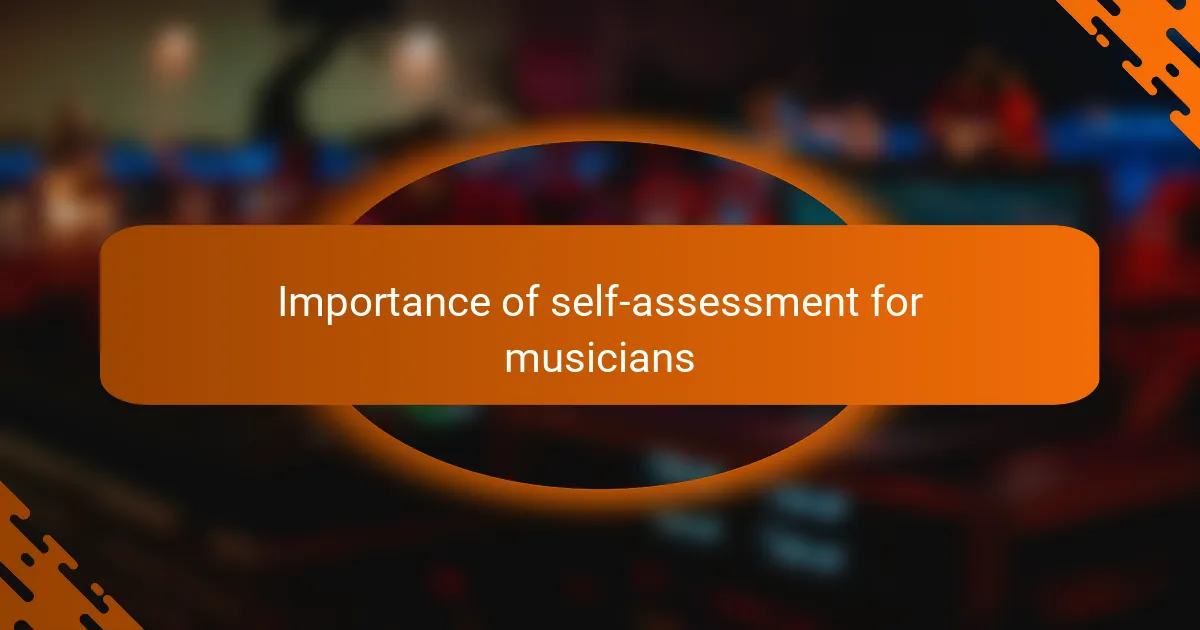
Importance of self-assessment for musicians
Self-assessment is crucial for musicians, as it allows us to reflect on our performances and identify areas for growth. After each gig, I take time to analyze not just what went well but also what didn’t serve the performance. This practice not only enhances my skills but also deepens my connection with the audience.
From my experience, self-assessment can feel a bit daunting at first. It’s like staring at a mirror, revealing both our strengths and weaknesses. However, it’s also incredibly rewarding, as it paves the way for improvement and future success.
I remember a time when I felt my energy was lacking during a performance. Reflecting on it afterward helped me realize that I needed to engage more with the crowd. This insight transformed my subsequent gigs, allowing me to create a more vibrant and interactive atmosphere.
| Self-Assessment Benefits | Potential Pitfalls |
|---|---|
| Identifies areas for growth | May lead to excessive self-criticism |
| Enhances performance skills | Can be emotionally challenging |
| Strengthens audience connection | Risk of overthinking |
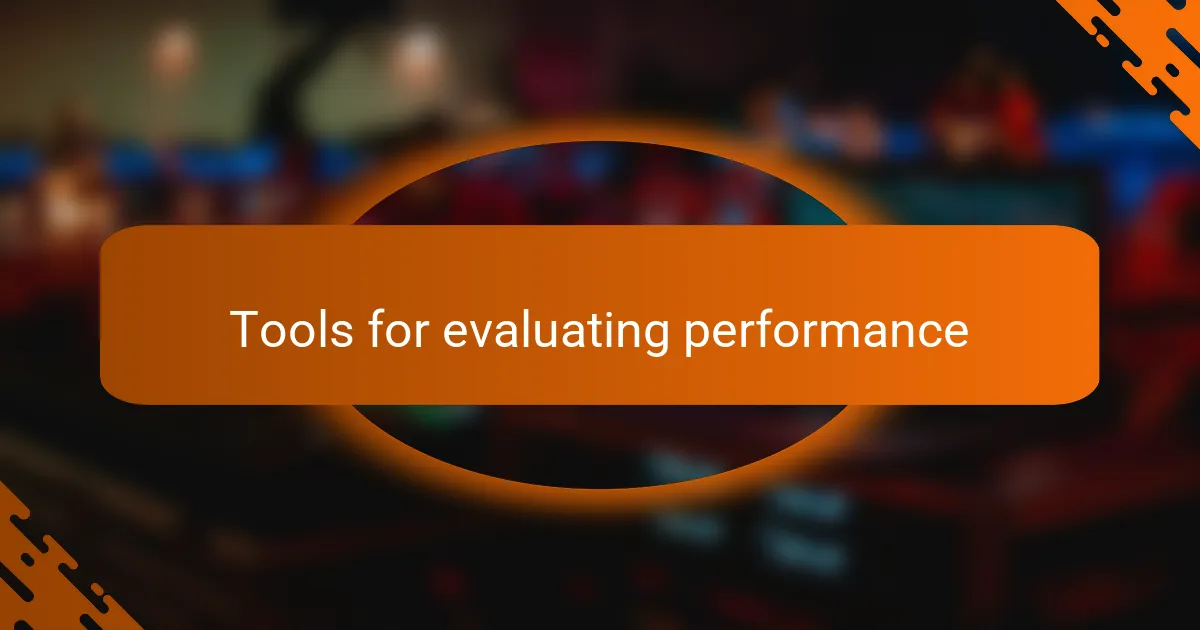
Tools for evaluating performance
Evaluating my performance requires practical tools that really make the process effective. One tool I find invaluable is recording my gigs. Listening back allows me to hear nuances I might have missed in the moment, like pitch issues or moments where my connection with the audience may have waned. It’s like having a friendly but critical friend who helps me identify those sneaky areas for improvement.
Another method I use is audience feedback. After a show, I often chat with friends, fellow musicians, and even fans. Their perspectives can be enlightening. Did they feel the energy dip at a certain point? Were there particular songs that stood out? Gathering this insight helps me see my performance through their eyes, which is crucial for understanding what truly resonates.
Lastly, utilizing performance checklists enhances my critique process. I create a simple list, focusing on key elements like song transitions and crowd interactions. When I go through this checklist post-gig, it’s a reality check that distills my experiences into actionable insights. This organized approach keeps me focused and encourages consistent growth—every gig is a chance to refine my art.
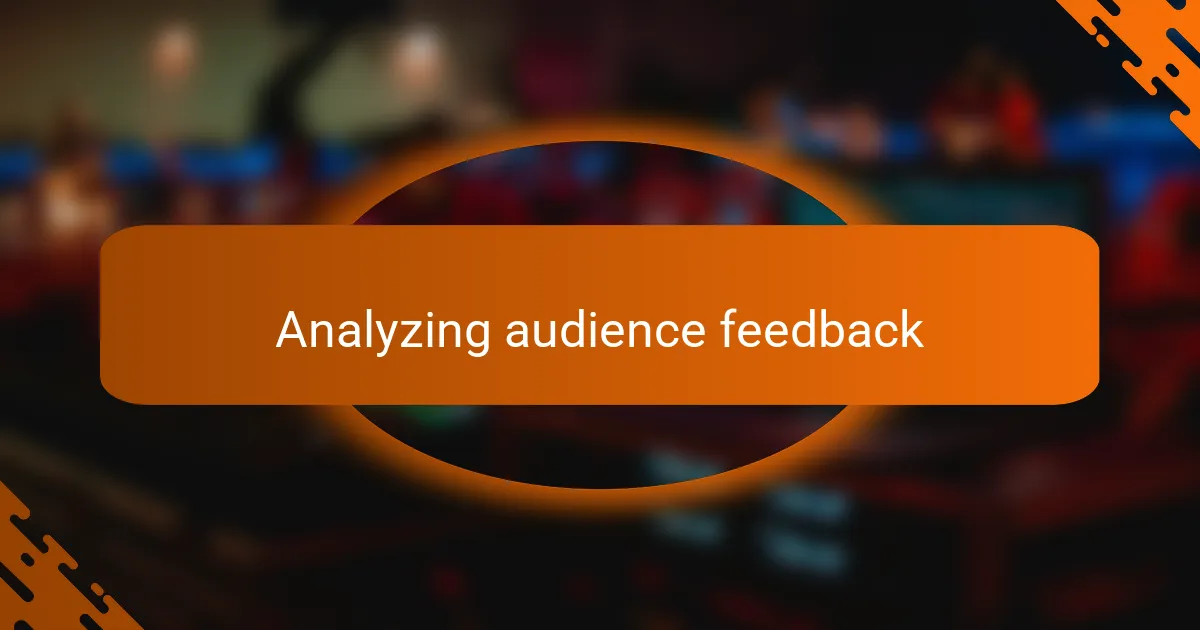
Analyzing audience feedback
After a gig, I often seek audience feedback to gain a different perspective on my performance. I find this exchange enlightening—sometimes, people notice things I completely overlooked. For instance, after one energetic set, a fan shared how a particular song ignited the room, while I initially thought my set was too energetic to follow up with ballads. This moment reminded me how important it is to tune into the audience’s reactions, as they can reveal the emotional undercurrents that I may not grasp.
I’ve also learned to listen for comments that indicate not just enjoyment, but connection. A fellow musician once told me that a shared moment during a song made it feel like we were all in the room together. That connection can sometimes be elusive, but hearing how it affected others motivates me to strive for that intangible magic each time I perform. Have you ever experienced a moment where the audience’s response transcended your own expectations? Those moments are what keep me pushing forward.
During one critique session, I received feedback that changed how I view my stage presence. An audience member mentioned they felt my energy dipped during a quiet part of the set. Initially, I felt defensive, thinking, “It was a soft song!” But then, reflecting on it, I realized that keeping the audience engaged is my responsibility, regardless of the song dynamics. It reshaped my approach, encouraging me to maintain energy even in softer moments—an invaluable lesson emerged from a simple conversation that I cherish.
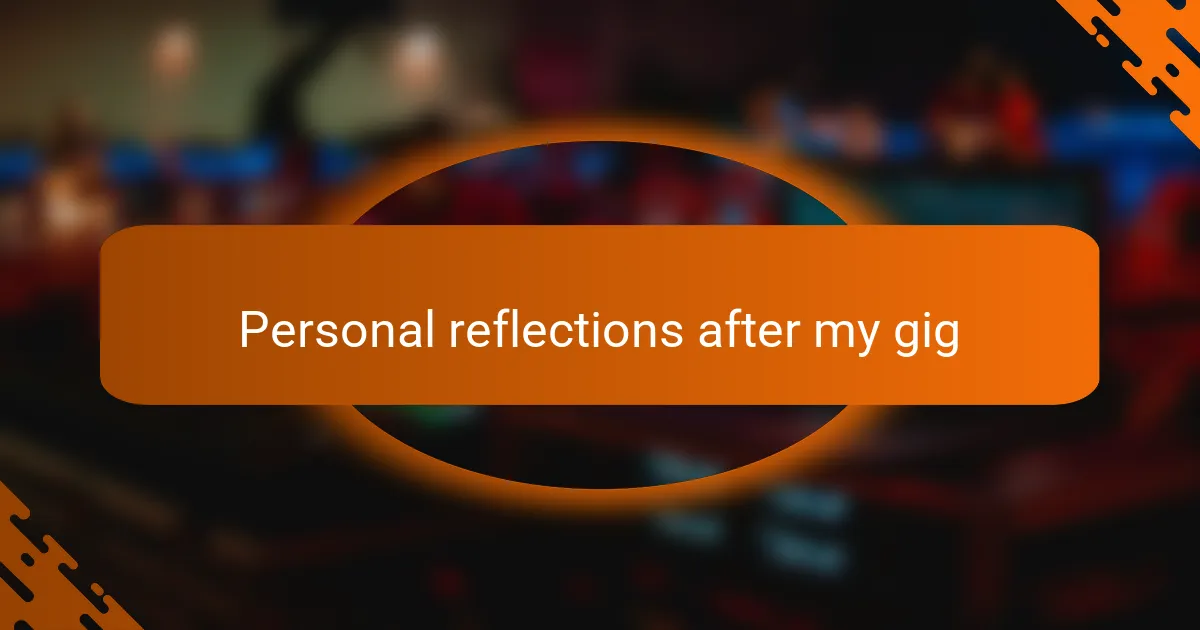
Personal reflections after my gig
After every gig, I take time to reflect on my performance, which has become a valuable part of my growth as a musician. One particular show stands out where the energy was electric, but I couldn’t shake the feeling that I missed a few opportunities to connect with the audience. That experience taught me the importance of not just playing the music, but really engaging with the crowd.
In my reflections, I consider various aspects of my performance and how they contributed to the overall experience. Here’s what I usually focus on:
- Song Selection: Did the setlist resonate with the audience?
- Stage Presence: Was I confident and engaging, or did I seem detached?
- Technical Execution: Were there any mistakes in playing or singing that need attention?
- Audience Interaction: How did I communicate with the crowd? Could I have created a deeper connection?
- Feedback from Others: What did my bandmates or friends think about my performance?
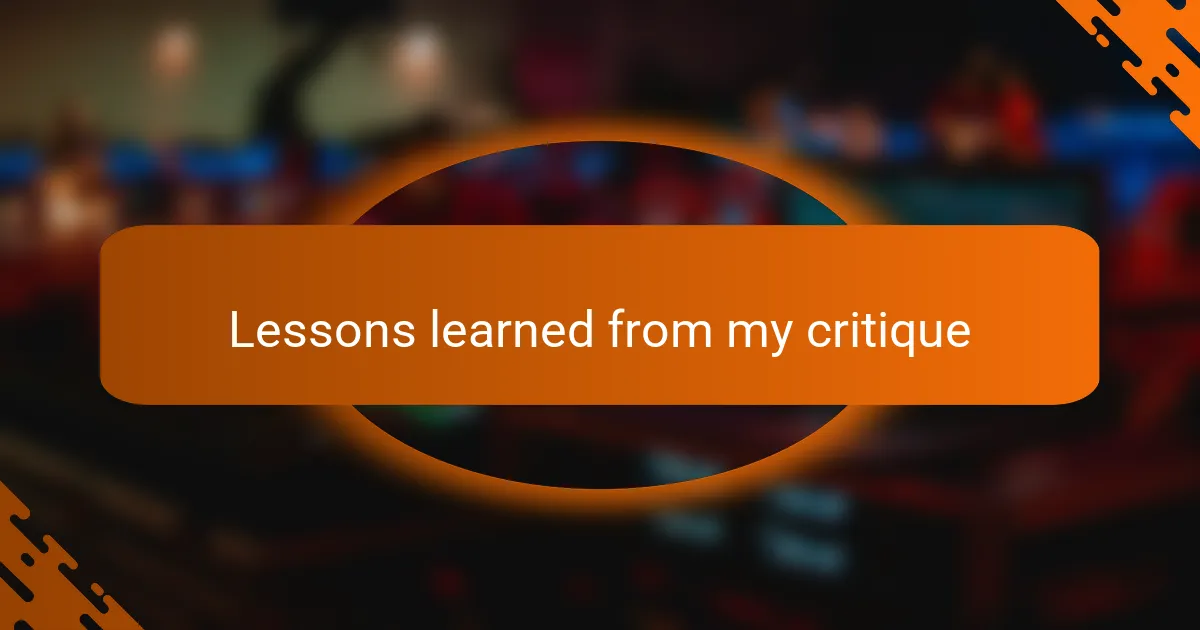
Lessons learned from my critique
Lessons learned from my critique often shape my growth as a musician. After a gig, I reflect on what went well and where I stumbled. For instance, I used to feel disheartened by any mistakes, but I’ve learned that those moments are teaching tools, helping me refine my skills and stage presence.
One key insight was realizing the importance of stage interaction. During one performance, I noticed how my lack of eye contact affected the audience’s engagement. Moving forward, I made a conscious effort to connect with my listeners, and that made all the difference in my next shows.
Here’s a comparison of my performance elements before and after my critique:
| Performance Element | Before Critique | After Critique |
|---|---|---|
| Stage Presence | Minimal engagement | Active interaction |
| Confidence | Nervousness | Assuredness |
| Musical Precision | Occasional errors | Increased accuracy |
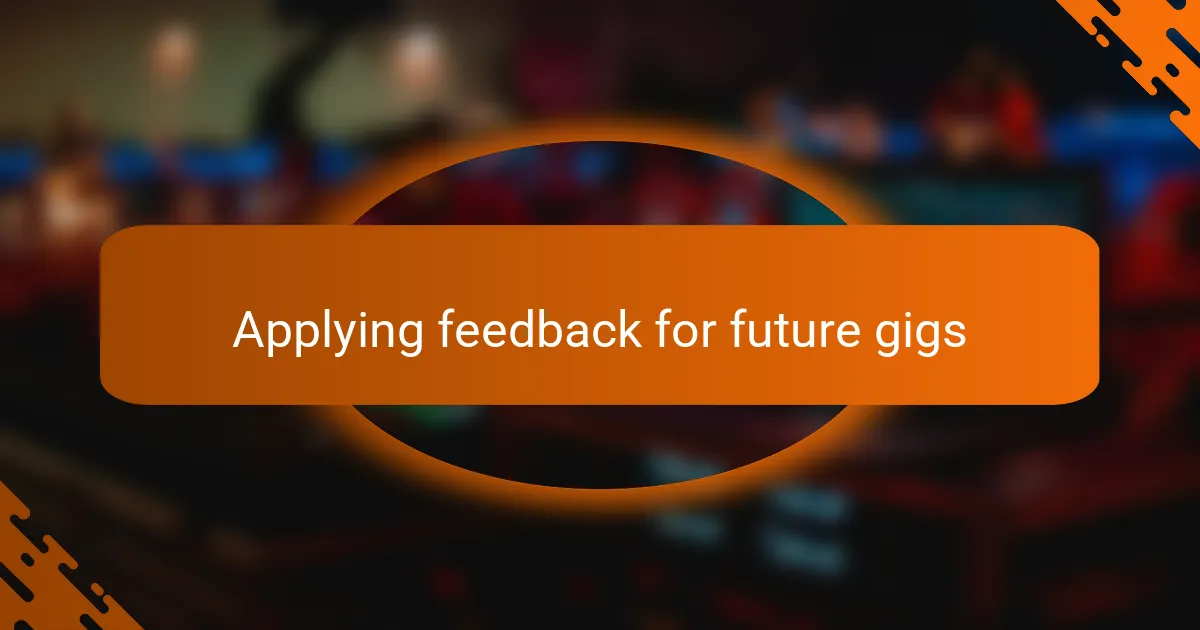
Applying feedback for future gigs
Applying feedback from previous gigs is crucial for continuous improvement. When I receive advice or constructive criticism, I try to incorporate it into my practice routine. For example, after one performance, a fellow musician pointed out the need for better crowd interaction. The following gig, I made an effort to engage with the audience more, asking questions and encouraging them to sing along. The shift in energy was palpable, and it made the experience more fulfilling for both me and the crowd.
I also find it helpful to focus on one or two specific areas needing attention for each upcoming gig. For instance, if I note that my song transitions were too abrupt last time, I set aside time to rehearse those shifts more smoothly. This targeted approach allows me to see tangible improvements over time. Have you ever felt like one small adjustment made a huge difference in your performance? I certainly have, and it reinforces the idea that even minor tweaks can lead to a more polished show.
After each gig, I jot down key takeaways from my critique session, creating a mini action plan for future performances. This could include practicing a particular song more or improving my vocal warm-ups to enhance my emotional delivery. By treating feedback as a roadmap for growth rather than a list of failures, I embrace the journey of becoming a better musician. It’s refreshing to remind myself that each gig is an opportunity to evolve and connect deeper with the audience.